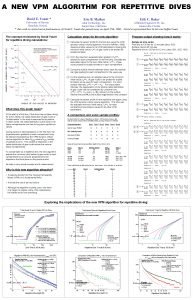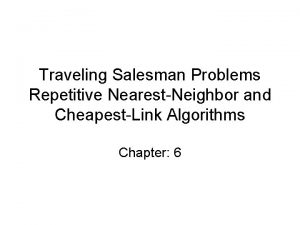A NEW VPM ALGORITHM FOR REPETITIVE DIVES David

- Slides: 1

A NEW VPM ALGORITHM FOR REPETITIVE DIVES David E. Yount * Eric B. Maiken Erik C. Baker University of Hawaii n&k Technology, Inc. Affiliated Engineers SE, Inc. Honolulu, Hawaii Santa Clara, California Gainesville, Florida * this work is carried out in fond memory of David E. Yount who passed away on April 27 th, 2000. David is represented here by his son Steffen Yount. The concept envisioned by David Yount for repetitive diving calculations: Calculation steps for the new algorithm: Program output showing how it works: 1 Calculate the ascent profile for the first dive using the VPM dynamic critical volume algorithm (Yount & Hoffman, 1986). Assume pristine values for all VPM parameters including the minimum initial radius, romin, of gas nuclei to be probed for bubble formation. Sample air dive series First dive to 120 fsw for 12 minutes (deco 10/2) Surface interval 45 minutes Repetitive dive to 120 fsw for 12 min. (deco 30/1, 20/2, 10/5) 2 From the maximum supersaturation gradient, Pssnew j , allowed for each compartment on the first dive, calculate the associated value for the new initial radius, ronew j , of gas nuclei probed for bubble formation in each compartment. DIVE #1 - FIRST DIVE TO 120 FSW FOR 12 MINUTES: ITERATION # 1 Cpt 2 Cpt 3 Cpt 4 Cpt 5 Cpt 6 Cpt 7 Cpt 8 Ro MIN 1. 00000 1. 00000 Pss. MIN 18. 5 18. 8 18. 9 19. 0 19. 1 19. 2 1 Cpt 9 Cpt 10 Cpt 11 Cpt 12 Cpt 13 Cpt 14 Cpt 15 Cpt 16 Ro MIN 1. 00000 1. 00000 Pss. MIN 19. 2 19. 2 3 During the surface interval between dives, track the residual inert gas loading for each compartment in the usual way. 4 For the repetitive dive, an adjusted value for the minimum initial radius, romin'j , of gas nuclei to be probed for bubble formation will be used for each compartment. For short surface intervals, romin'j = romin + ro j. For long surface intervals, the regeneration of the pristine radial distribution of gas nuclei may be considered by using the form, romin'j = romin + ro j exp ( -ts / s ) where ts is the surface interval time and s is the surface regeneration time constant. 5 Calculate the ascent profile for the repetitive dive again using the VPM dynamic critical volume algorithm. This time use the adjusted minimum initial radius, romin'j , for each compartment and pristine values for all other VPM parameters. What does this graph mean? At the start of a first dive, if the diver has not been diving for a few weeks, the radial distribution of gas nuclei or “bubble seeds” in the body is assumed to be pristine. In other words, the radial distribution is the same in all tissue compartments and has its long-term equilibrium values. A comparison and some sample profiles: Suunto Vyper RGBM 10 6 9 5 During ascent or decompression on the first dive, the supersaturation gradients in each compartment may be relaxed (increased) by the VPM dynamic critical volume algorithm to allow Nactual versus Nsafe number of bubbles to form. This causes a dispersion in the radial distribution of gas nuclei across the various tissue compartments. New VPM Algorithm 9 8 8 8 Decometer RGBM 12 9 10 9 9 9 Technical RGBM 13 11 11 10 10 9 To compensate on a repetitive dive, the new algorithm adjusts the minimum initial radius of gas nuclei in each compartment by an amount proportional to the dispersion that took place on the previous dive. Its really a very simple concept and it makes sense! Why is this new algorithm attractive? • It extends directly from the Varying Permeability Model (VPM) on a fundamental level. • It avoids the use of ad hoc factors. • Although the algorithm is pretty green (we have only begun to explore many of its implications), the results so far look promising. 2 2 3 Deco 1 10/1 40/100 no deco 30 60 120 Dive 2 40/100 Deco 2 10/4 10/1 no deco 160/7 30/1, 20/1, 10/3 20/1, 10/2 Deco 1 1 2 2 2 3 2 2 2 4 4 5 7 10 8 12 Surface Interval 120 Deco 2 1 1 2 2 3 4 4 6 9 12 11 19 2 TDECO = 19. 5 min Ro NEW Pss. NEW Cpt 1. 41834 33. 6 Cpt 2. 46320 31. 3 Cpt 3. 51947 29. 0 Cpt 4. 57943 26. 9 Cpt 5. 64368 25. 1 Cpt 6. 70466 23. 7 Cpt 7. 76284 22. 5 Cpt 8. 81500 21. 6 Ro NEW Pss. NEW Cpt 9. 85896 21. 0 Cpt 10. 88943 20. 5 Cpt 11. 91082 20. 2 Cpt 12. 92840 20. 0 Cpt 13. 94274 19. 9 Cpt 14. 95448 19. 7 Cpt 15. 96389 19. 6 Cpt 16. 97140 19. 5 ITERATION # 2 ITERATION # 3 TDECO = 8. 5 min Ro NEW Pss. NEW Cpt 1. 28136 46. 2 Cpt 2. 34230 39. 6 Cpt 3. 41975 33. 9 Cpt 4. 50174 29. 8 Cpt 5. 58757 26. 7 Cpt 6. 66624 24. 5 Cpt 7. 73830 23. 0 Cpt 8. 80025 21. 9 Ro NEW Pss. NEW Cpt 9. 85050 21. 1 Cpt 10. 88429 20. 6 Cpt 11. 90750 20. 3 Cpt 12. 92627 20. 1 Cpt 13. 94138 19. 9 Cpt 14. 95363 19. 7 Cpt 15. 96336 19. 6 Cpt 16. 97106 19. 5 ITERATION # 3 ITERATION # 4 TDECO = 4. 5 min Ro NEW Pss. NEW Cpt 1. 21952 57. 1 Cpt 2. 28738 45. 7 Cpt 3. 37445 37. 0 Cpt 4. 46681 31. 4 Cpt 5. 56288 27. 5 Cpt 6. 64978 25. 0 Cpt 7. 72810 23. 2 Cpt 8. 79429 22. 0 Ro NEW Pss. NEW Cpt 9. 84716 21. 1 Cpt 10. 88229 20. 6 Cpt 11. 90622 20. 3 Cpt 12. 92547 20. 1 Cpt 13. 94088 19. 9 Cpt 14. 95331 19. 7 Cpt 15. 96316 19. 6 Cpt 16. 97094 19. 5 4 TDECO = 3. 5 min SURFACE INTERVAL: 45 MINUTES 1 4 5 Cpt 1 Cpt 2 Cpt 3 Cpt 4 Cpt 5 Cpt 6 Cpt 7 Cpt 8 Ro MIN 1. 77874 1. 71103 1. 62415 1. 53200 1. 43615 1. 34944 1. 27129 1. 20525 Pss. MIN 13. 8 14. 3 14. 8 15. 3 15. 8 16. 3 16. 8 17. 3 4 5 Cpt 9 Cpt 10 Cpt 11 Cpt 12 Cpt 13 Cpt 14 Cpt 15 Cpt 16 Ro MIN 1. 15249 1. 11745 1. 09357 1. 07437 1. 05899 1. 04658 1. 03676 1. 02900 Pss. MIN 17. 7 18. 0 18. 3 18. 4 18. 6 18. 7 18. 8 18. 9 Trimix 16/33 dives to 250 fsw for 30 min. Deco mixes - air at 100 fsw, O 2 at 20 fsw: Stop 170 160 150 140 130 120 110 100 90 80 70 60 50 40 30 20 10 ITERATION # Dive 1 Dive 2 Dive 3 Dive 4 Dive 5 Dive 6 Surface Interval 30 60 120 1 DIVE #2 - REPETITIVE DIVE TO 120 FSW FOR 12 MINUTES: Deep air forward and reverse profiles (depth in fsw / time in min): Dive 1 160/7 ITERATION # No-deco limits for 3 days of repetitive air diving - 120 fsw dives, twice a day, with 45 minute surface interval (RGBM profiles courtesy of Bruce R. Wienke): Computer/Algorithm 1 5 5 ITERATION # 1 ITERATION # 2 TDECO = 30. 5 min Ro NEW Pss. NEW Cpt 1. 70791 23. 0 Cpt 2. 75654 22. 3 Cpt 3. 81045 21. 5 Cpt 4. 85962 20. 8 Cpt 5. 90304 20. 3 Cpt 6. 93583 19. 9 Cpt 7. 96004 19. 6 Cpt 8. 97638 19. 4 Ro NEW Pss. NEW Cpt 9. 98657 19. 3 Cpt 10. 99184 19. 3 Cpt 11. 99472 19. 2 Cpt 12. 99660 19. 2 Cpt 13. 99782 19. 2 Cpt 14. 99861 19. 2 Cpt 15. 99911 19. 2 Cpt 16. 99943 19. 2 ITERATION # 3 TDECO = 16. 5 min Ro NEW Pss. NEW Cpt 1. 48172 30. 2 Cpt 2. 55353 27. 5 Cpt 3. 64168 25. 0 Cpt 4. 72899 23. 1 Cpt 5. 81071 21. 6 Cpt 6. 87455 20. 7 Cpt 7. 92232 20. 1 Cpt 8. 95455 19. 7 Ro NEW Pss. NEW Cpt 9. 97446 19. 5 Cpt 10. 98465 19. 4 Cpt 11. 99016 19. 3 Cpt 12. 99372 19. 3 Cpt 13. 99601 19. 2 Cpt 14. 99748 19. 2 Cpt 15. 99841 19. 2 Cpt 16. 99900 19. 2 ITERATION # 3 ITERATION # 4 TDECO = 12. 5 min Ro NEW Pss. NEW Cpt 1. 40688 34. 3 Cpt 2. 48480 30. 3 Cpt 3. 58337 26. 7 Cpt 4. 68348 24. 1 Cpt 5. 77878 22. 2 Cpt 6. 85376 21. 0 Cpt 7. 90986 20. 2 Cpt 8. 94754 19. 8 Ro NEW Pss. NEW Cpt 9. 97067 19. 5 Cpt 10. 98244 19. 4 Cpt 11. 98877 19. 3 Cpt 12. 99286 19. 3 Cpt 13. 99547 19. 2 Cpt 14. 99715 19. 2 Cpt 15. 99821 19. 2 Cpt 16. 99887 19. 2 ITERATION # 4 ITERATION # 5 TDECO = 10. 5 min Ro NEW Pss. NEW Cpt 1. 36795 37. 2 Cpt 2. 44866 32. 1 Cpt 3. 55237 27. 7 Cpt 4. 65914 24. 6 Cpt 5. 76170 22. 5 Cpt 6. 84271 21. 2 Cpt 7. 90330 20. 3 Cpt 8. 94388 19. 8 Ro NEW Pss. NEW Cpt 9. 96871 19. 5 Cpt 10. 98131 19. 4 Cpt 11. 98807 19. 3 Cpt 12. 99242 19. 3 Cpt 13. 99520 19. 2 Cpt 14. 99698 19. 2 Cpt 15. 99810 19. 2 Cpt 16. 99880 19. 2 ITERATION # Exploring the implications of the new VPM algorithm for repetitive diving: 5 TDECO = 9. 5 min

